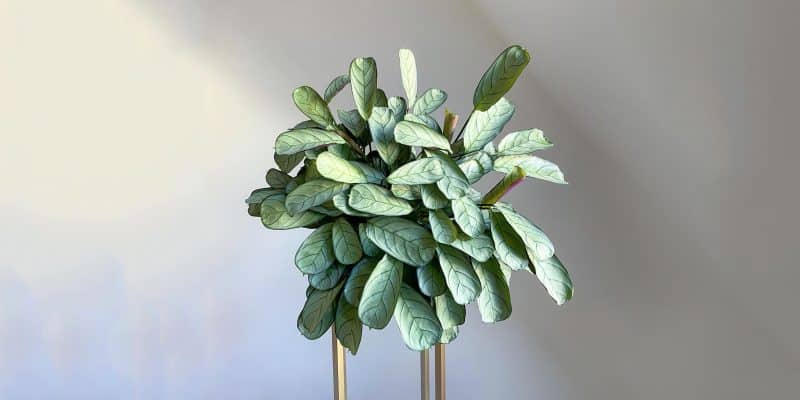Meet the enchanting never never plant, also known as fishbone prayer plant or bamburanta, a houseplant that lives up to its whimsical name and instantly brings a touch of fairy-tale charm to your home. There’s something magical about a plant that promises to take you to a world of never-ending beauty and wonder.
With its lush, velvety leaves and easy-going nature, it’s easy to fall in love with this captivating plant. Luckily, never never plant care is equally easy.
With our tips and tricks, you’ll find yourself living happily ever after, surrounded by the soft, tropical greenery of your new favorite plant. Let’s uncover the hidden treasures of this enchanting member of the prayer plant family.
Table of Contents
Never Never Plant Plant Care Guide
History, habitat, and characteristics
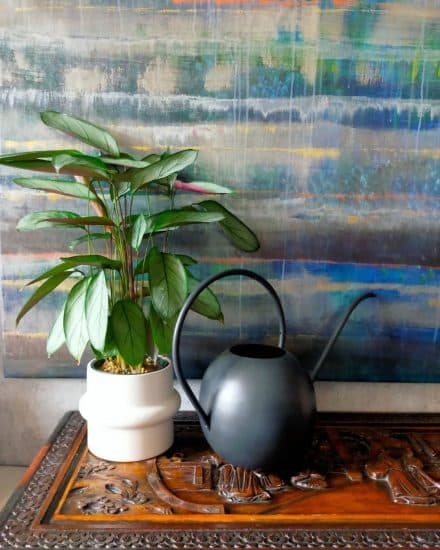
Never never plant (Ctenanthe) hails from Brazil’s lush rainforests. This tropical plant features alluring leaves that seem to perform a mesmerizing dance as they unfurl, adding a pop of color, striking fishbone patterns, and a touch of whimsy to your indoor garden.
Now, picture this: young leaves rolled up like little cigars, gradually unfurling as they grow. You’ll witness this charming spectacle as your never never plant reaches about 80% development. And as your new companion matures, it’ll get bushier, becoming the eye-catching centerpiece in your collection.
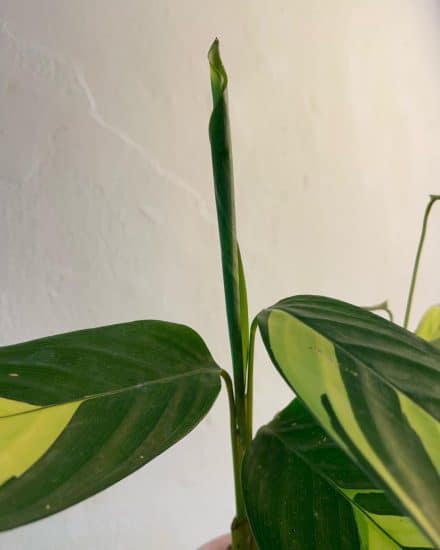
Fun fact: During warm months, your tropical plant might produce petite white or yellow flowers sprouting from the base of the leaves. But keep in mind, these blossoms are quite a rare treat.
To keep your little friend looking neat, simply snip the flower stalk back to the base once it has withered. This small gesture will encourage new growth and ensure that your never never plant keeps thriving.
Varieties
We’ll give you a quick overview of a few of our favorite Ctenanthe varieties:
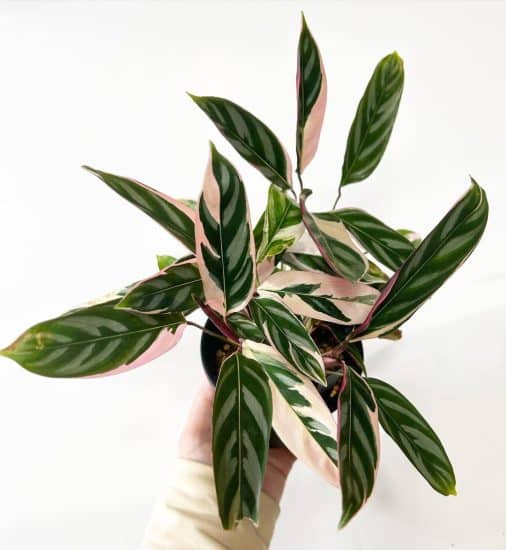
Ctenanthese oppenheimiana features an exquisite leaf pattern that immediately commands your attention. The plant’s large, elongated leaves are deep, rich green, and adorned with striking, silvery-white-pink bands that run parallel to the leaf’s veins. This mesmerizing foliage stands out even more thanks to the vivid deep purple undersides of the leaves, creating an ambiance of sophistication and elegance in any indoor space.
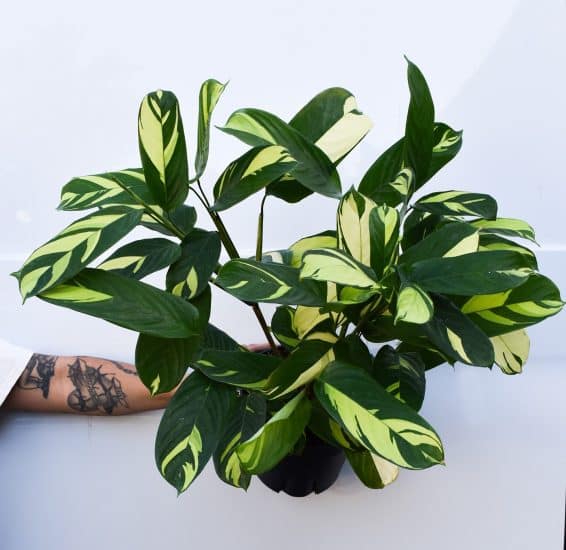
Ctenanthe lubbersiana, also known as Calathea ‘Golden Mosaic’, is truly a breathtaking plant that instantly brightens up any room. This plant features elongated leaves with a vivid blend of green shades, creating an intricate mosaic-like pattern. Feature a lush, green base, overlaid with lighter green, almost golden variegated foliage that radiates from the central vein.
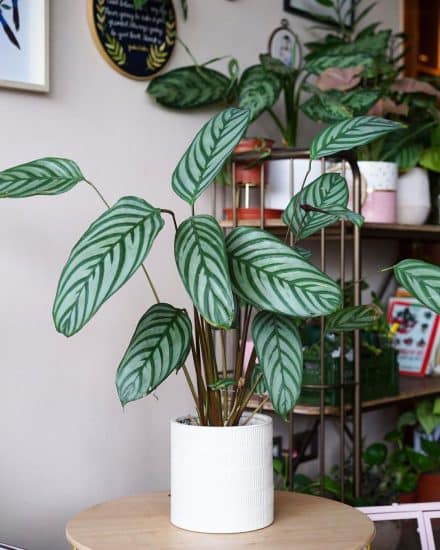
Ctenanthe setosa is known for its robust, large, and oval-shaped leaves. The plant’s foliage is characterized by a lush, deep green color, embellished with an intricate network of fine, silvery lines radiating from the leaf’s central vein. This striking pattern is set against the leaf’s velvety texture. The underside of the leaves exhibits a rich, dark purple hue, adding yet another layer of depth to this astounding plant.
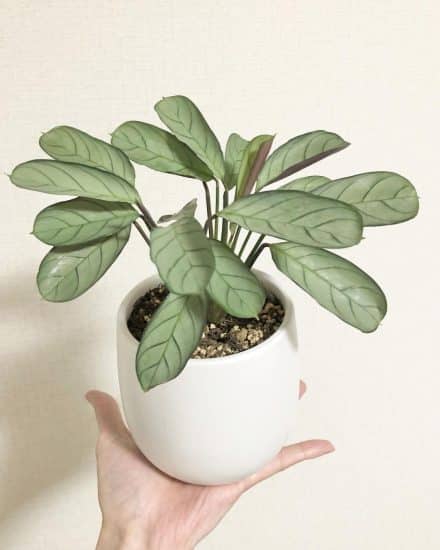
Ctenanthe Burle Marxii ‘Amagris’, often referred to as the “Fishbone Prayer Plant,” features relatively small, elongated leaves in a deep green color, marked by a mesmerizing, fishbone-like pattern of contrasting, silvery-white veins. These alternating and curving veins create a hypnotic effect, reminiscent of waves undulating across the leaves.
Light
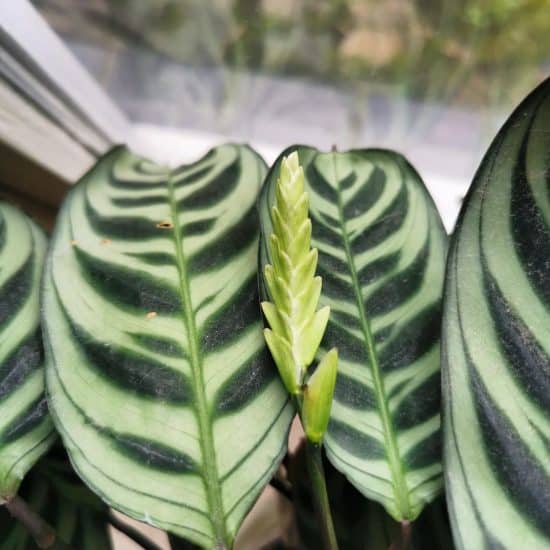
Ctenanthe plants, never never plant included, prefer bright, indirect light to maintain their striking variegation. But be careful — if they get too much direct sun, those gorgeous leaves can fade and lose their variegation.
However, if they don’t get enough light, the leaves can turn dark green and lose their variegation that way as well. East- or north-facing windows are ideal for Ctenanthe plants to get all the bright filtered light they need.
Our lighting tips:
- If you notice its leaves fading, losing their variegation, or looking sun-bleached or scorched, that’s a sign your plant might be getting too much direct sun. In that case, try moving the never never plant away from harsh light or use a sheer curtain to filter the sunlight.
- Leaves turning dark green and losing their variegation are signs that your plant needs more light. To solve this, move your plant to a brighter spot or bring in some artificial lighting, like full spectrum LED lights, to give it an extra boost.
Water
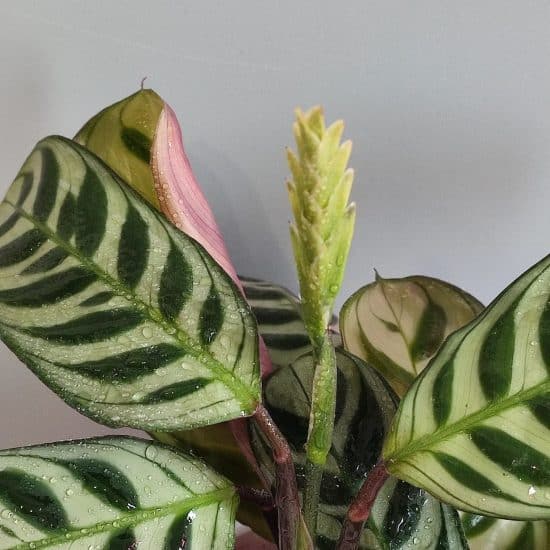
Ctenanthe plants really don’t like drying out. If you’re not giving your never never plant enough water, you might find brown tips and leaf loss. To keep your plant happy, keep the soil moist, but not wet.
Too much water can cause serious issues for your plant’s root system. If you see yellow leaves, mushy stems, and soil that’s always damp, slow down your watering and let the soil dry out a bit.
Our watering tips:
- Whether you prefer a trusty moisture meter or just using your finger, check the soil’s wetness about an inch or two below the surface. When it feels almost dry, it’s time to water your plant.
- Your never never plant might need a bit more water during rapid growth periods and a little less when it’s feeling sleepy during the winter months.
- Keep an eye on leaf color and texture, as well as stem firmness. These clues can help you determine if your plant needs more or less water.
Temperature and humidity
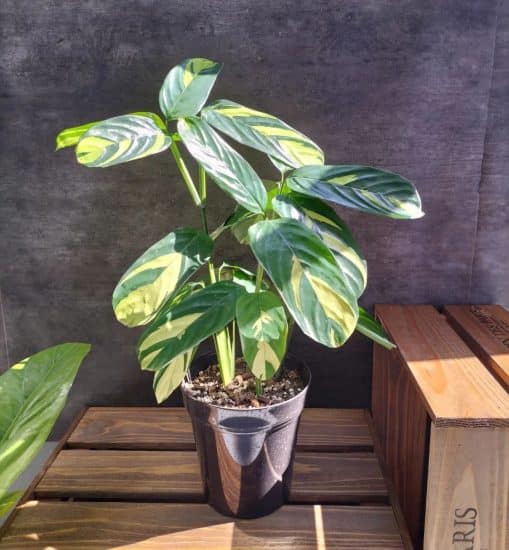
Never never plants are happiest in mild indoor temperatures ranging from 65 to 80°F. They enjoy a consistent temperature throughout the day but can tolerate a slight drop at night. Keep your plant away from open windows and heating or cooling vents to avoid temperature fluctuations that might stress it.
Temperatures that are too high or low can lead to wilting, drooping leaves, or even stunted growth. Adjusting the indoor environment to meet your plant’s needs will help it flourish and stay healthy.
While never never plants do enjoy a degree of humidity, they’re not high-humidity lovers like some other South American flowering plants. Aim for humidity levels around 40%-60% for optimal growth. Curling leaves or brown leaf tips on juvenile leaves are a sign that conditions are too dry.
To maintain adequate humidity: Use a pebble tray, occasionally mist the plant, or place it near other plants to benefit from natural transpiration.
Soil and planting
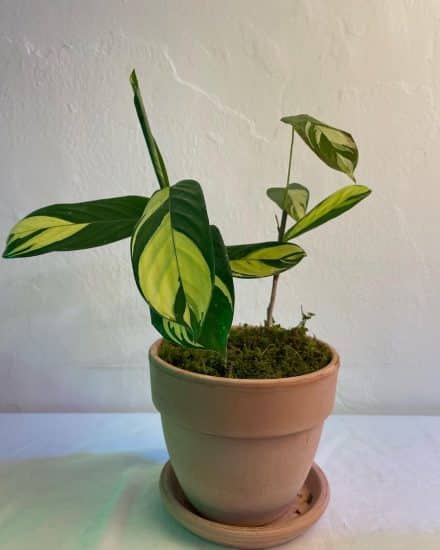
Never never plant thrives in rich, well-drained soil that retains moisture. To achieve this ideal balance, amend fresh potting soil with coconut coir, which helps hold and retain water.
To boost the natural biome within the potting medium, consider adding a product like Bio-tone Starter Plus.
Signs of poor soil and potential issues: Choosing the wrong potting mix can lead to various problems for your never never plant. Signs of poor soil include slow growth, yellowing leaves, and weak or rotting roots. Address these issues by repotting the plant in a more suitable soil mix that is nutrient-rich and well-draining.
Feed your never never plant once a month with organic fertilizer for about 10 months of the year, skipping December and January. Over-fertilization can lead to leaf tip burn, so be sure to follow product directions carefully.
If you notice symptoms of over-fertilization, such as yellowing leaves or burned tips, flush the soil to remove excess nutrients and reduce the frequency or concentration of the fertilizer.
Proper pruning is essential for maintaining the health and appearance of your never never plant. Remove yellow or dying leaves by cutting them down to the base of the plant using a clean knife. This helps promote new growth and keeps the plant looking fresh and full.
Repotting
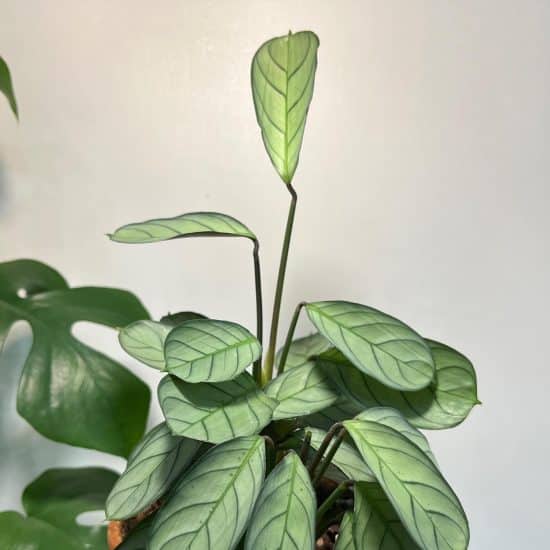
Repot your never never plant every two years, or when the plant-to-pot ratio reaches 3:1. Use fresh soil and, if the plant hasn’t outgrown the 2:1 ratio, consider placing it back in the same pot. A pot that’s too large can lead to overwatering.
Repotting is an excellent opportunity to refresh the soil and ensure that your never never plant continues to thrive. When repotting, make sure the soil line remains consistent to prevent waterlogging and maintain a healthy Ctenanthe.
Propagation
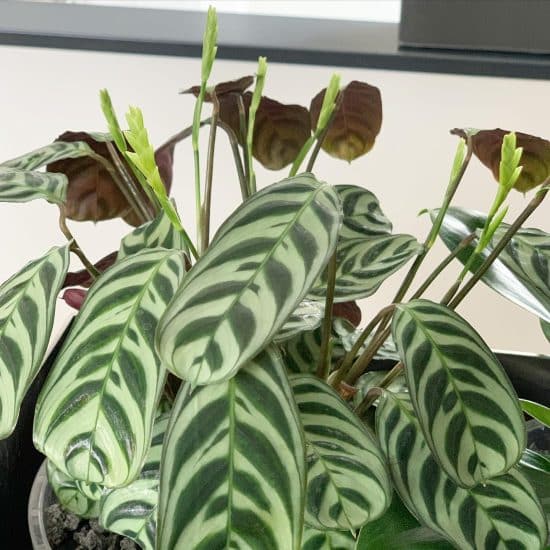
Looking to multiply your never never plant collection or share the green goodness with friends? We’ve got you covered! Check out these simple propagation methods: stem cutting and division.
Propagating never never plant using stem cuttings:
- Create a rooting medium by adding Bio-tone Starter (optional) and filtered water to potting soil in a suitable container.
- Pick a stem from the mother Ctenanthe plant — bonus points if it already has a root nubbin. Snip the stem about 2-3 inches behind the leaves using clean shears.
- Optional: Dip the cut end in rooting hormone — it’s not a must, but it can help speed up the process.
- Make a hole in the prepared potting mix and pop the cut end of the stem in, ensuring you cover the base of the leaves and any root nubbins.
- Secure the stem cuttings by pressing the soil gently around them.
- Give the soil a light drink with filtered water, making sure you don’t go overboard with the watering to prevent waterlogging.
- Find the perfect spot for the cutting — somewhere with indirect light, warmth, and humidity, such as near a north-facing window.
Propagating never never plant by division:
- Gently separate small divisions from the mother plant at the root level.
- Create a comfy home for the divisions — mix in some Bio-tone Starter and fill suitable containers with moist soil.
- Place each divided plant in the prepared container, covering the roots and keeping the base of the stem at soil level.
- Water cautiously — remember, you don’t want to drown the plants — and find a spot with filtered, indirect light.
Propagation tips:
- Always use clean shears when snipping stems — nobody wants a sick plant.
- High humidity is your plant’s best friend for successful propagation! Don’t be shy to mist or use a humidifier to maintain high humidity.
- When propagating, opt for an airy potting medium, such as Espoma potting soil mixed with perlite.
Common Issues
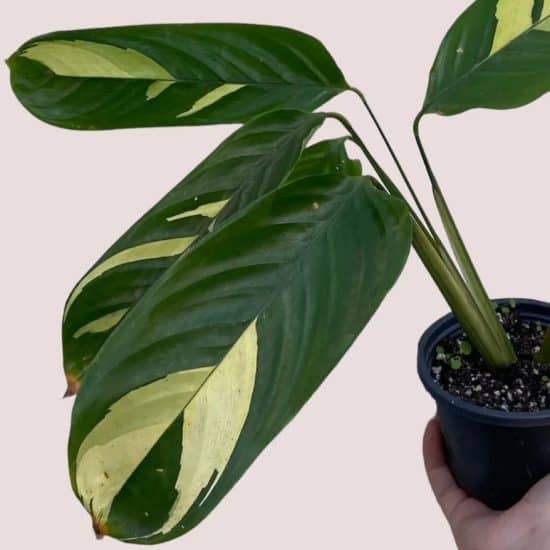
Whether you’re new to houseplants or have been collecting them for decades, a few common issues will inevitably arise. Here are some you may experience with never never plants.
Yellow leaves
When leaves start to turn yellow and fade, your plant is likely telling you it’s getting too much sun. Even though these tropical plants love bright, indirect light, they’re not big fans of direct sunlight.
If you spot dark green leaves losing their lovely variegation, however, that’s a sign your never never plant needs more light. Experiment with the plant’s position, such as moving it to a different window, to find its sweet spot for light exposure.
Droopy leaves
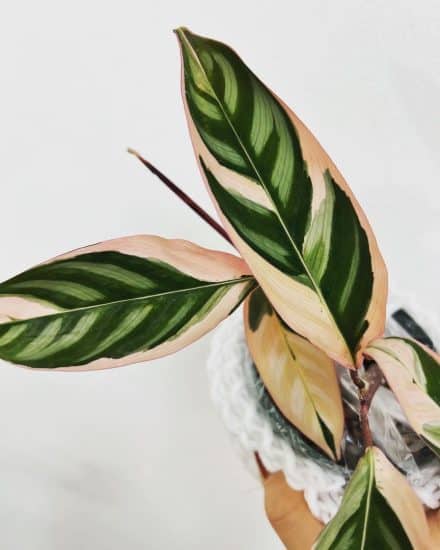
Droopy leaves paired with consistently wet soil indicate waterlogging. To fix this, gently take your plant out of the pot, trim away any damaged roots, and give it a fresh home potting soil that drains well. Check the soil moisture between waterings. If it feels just dry, you’ll avoid this problem in the future.
Crispy leaf tips
Crispy leaf tips, or browning tips, especially on juvenile leaves, are usually a sign that your never never plant isn’t getting enough humidity. But don’t worry, there are a couple of things you can do.
First, you could place a humidifier near your plant, which will add moisture to the air. For best results, run your humidifier for at least six hours a day. Just be sure to keep it clear of fabrics and wood, or you risk damaging your belongings.
Another solution is to use a pebble tray. Just grab a shallow dish, add a layer of pebbles or small stones, and fill it with water, stopping just below the top of the pebbles. Place your plant on top, making sure the pot isn’t sitting in the water, and voilà! You’ve made your plant a little humidity haven.
Pests and diseases
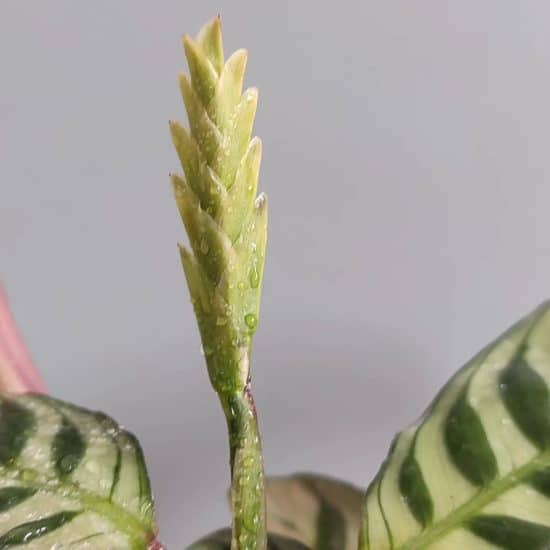
Spider mites
Ctenanthe, like many other indoor houseplants, can sometimes fall prey to pesky spider mites. Spotting them might be tough since they’re super tiny, but here’s a clue: they leave visible webbing on the leaves and stems. Feeding on its sap, they can weaken your beloved fishbone prayer plant, causing leaf discoloration and damage.
If you spot fine webs on the underside of the leaves or along the stems (maybe even some small yellowish, or brownish spots on the leaves), you’ve got yourself a spider mite situation.
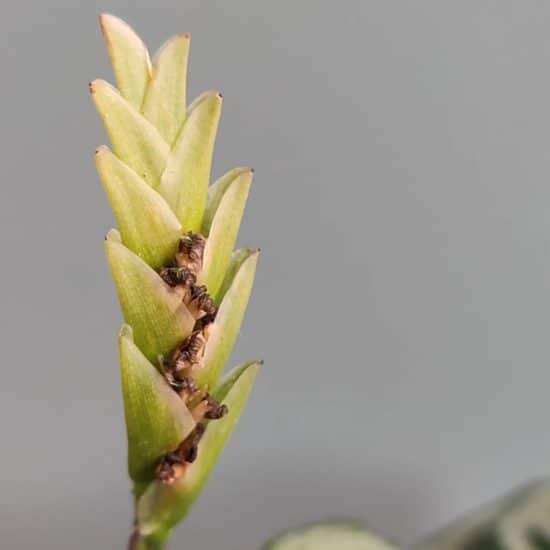
To remedy this, use a damp cloth to wipe off the intruders. Next, treat your plant with a neem oil solution or a specific miticide, making sure to cover every nook and cranny (both sides of the leaves, don’t forget!). Follow the instructions on the product label, and keep at it every week or two until you send those mites packing.
To prevent these unwelcome guests from returning, do your plant a favor and maintain proper humidity levels, and occasionally rinse its leaves with water, which will limit dust and deter mites.
Root rot
This issue is usually caused by overwatering or poor drainage (soggy soil and decaying roots, not a good combo). If you notice yellowing leaves, wilting, and a not-so-pleasant smell coming from the potting mix, it’s time to investigate.
Here’s how to confirm if it’s root rot: gently remove your Ctenanthe from its pot and take a good look at the roots. Healthy roots should be white or light tan, while rotting roots will be dark, slimy, and kind of mushy.
If they are, don’t panic! Simply trim away any affected roots using clean scissors. Next, repot your fishbone prayer plant in fresh, well-drained soil (don’t forget to use a clean pot with proper drainage holes). Add materials like perlite, pumice, or LECA to the soil mix for better aeration and drainage — your plant will thank you.
To avoid rot in the future, only water your never never plant once the top 2 inches of soil feel dry. Make sure the pot has adequate drainage holes and consider adding a layer of drainage material at the bottom of the pot (it helps keep water from pooling around the roots).
Conclusion
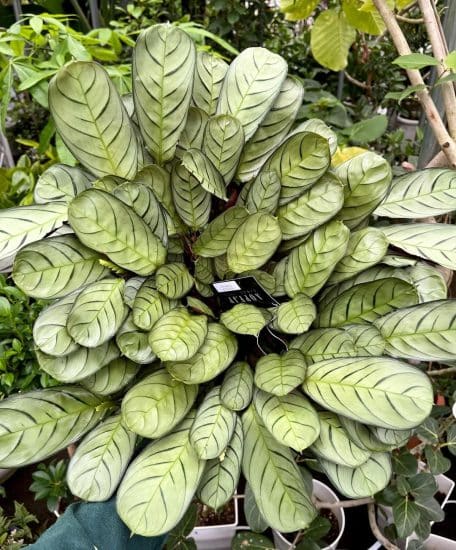
Ctenanthe plants, with their captivating patterns and mesmerizing, unfurling leaves, are truly a sight to behold. With a solid understanding of their care requirements, you’re ready to embark on a magical journey with your very own never never plant.
Our never never plant care summary:
- Place your plant in filtered light, adjusting its location as needed to avoid too much or too little light.
- Keep the soil consistently moist but well-draining to avoid root rot issues.
- Maintain indoor temperatures between 65-80°F and humidity levels around 40%-60% to ensure optimal growth.
- Use a rich, well-draining soil that retains moisture, and fertilize once a month during the growing season.
- Propagate via stem cutting or division to expand your plant collection or share with other plant enthusiasts.
If you have any questions or need further guidance, feel free to reach out to us. And if you loved this guide, share it with your friends and fellow plant fans!
FAQ
Why is it called the never never plant?
It’s not clear, though some speculate it’s somehow a playful spin on the plant’s botanical name, Ctenanthe. Another possibility is that the name hints at the enchanting way its leaves unfurl and dance, making you feel like you’ve ventured into a mesmerizing fairy tale.
Can a never never plant be outside?
Yes, but with a little bit of caution.
The never never plant is native to Brazil’s tropical rainforests, so it loves a warm and humid environment. If you live in a region with similar conditions (e.g., USDA Hardiness Zones 10-12), your plant buddy will likely thrive outside. Just protect it from direct sunlight — the intense rays can scorch its delicate leaves.
Are Ctenanthe hard to care for?
Ctenanthe plants have a reputation for being fussy, but don’t let that deter you! They require bright, indirect light, well-draining soil, and a moderately humid environment. Keep the soil consistently moist but never soggy, and be mindful to avoid cold drafts or significant temperature fluctuations.

